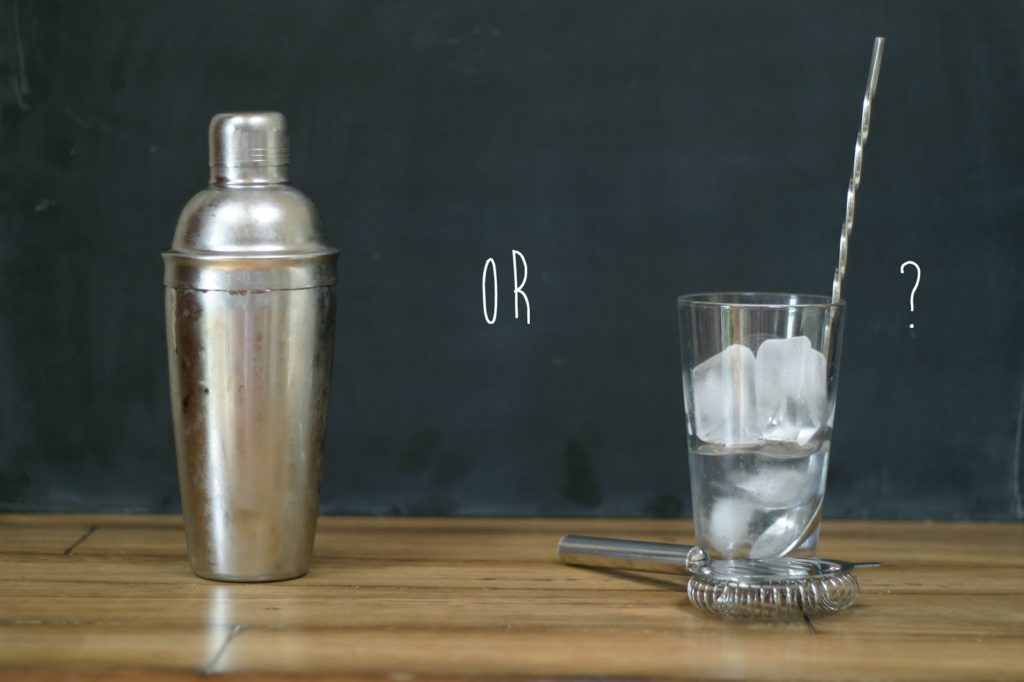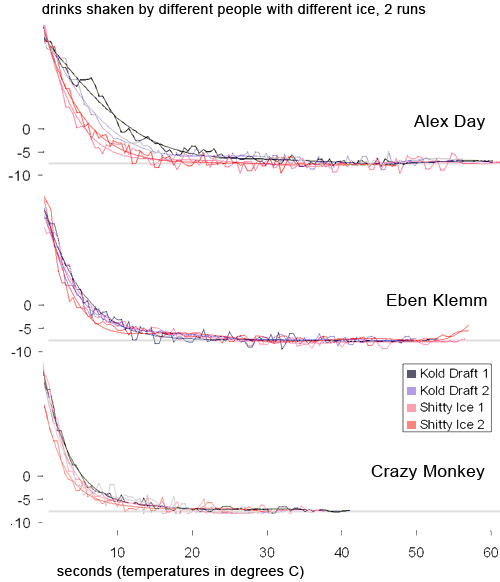The answer: If there’s any kind of non-alcoholic mixer, shake. If it’s all spirits, stir.
Of course we all know the exception, a certain British spy who likes his Martinis “shaken, not stirred,” even though a Martini firmly falls into the latter category; we’ll talk more about him on Friday. But to understand why you might do one and not the other, you have to understand what you’re trying to achieve, and what you don’t want to happen to your cocktail. Pour yourself a drink and get ready for some science!
Mixing a drink with ice does three main things: it combines the ingredients together, it chills the drink, and it dilutes the drink. Let’s talk about each of these in turn.
1. Combining the ingredients. This may seem like a very basic thing, but it’s actually at the heart of the shaking vs. stirring issue. If you’re making a cocktail consisting entirely of alcohol, like a Martini, Manhattan, or Negroni, all of your ingredients are going to be roughly the same density. This means they will mix readily and stay that way. Stirring does a great job of combining them.
But if your cocktail contains other ingredients like fruit juice, simple syrup, cream, or egg whites, you’re going to be dealing with some very different densities, and they will not mix and stay mixed as readily. Shaking emulsifies and combines them.
2. Chilling the drink. Some people think that shaking will make a drink colder than stirring, but that’s not true. It takes longer to get a stirred cocktail down to the same temperature as a shaken one, but once they reach a lower limit, that’s it. Eben Klemm, an MIT-geneticist-turned-mixologist, has shown that you generally can’t get a cocktail any colder than -7 degrees Celsius (about 19 degrees Fahrenheit). So if you’re doing your shaking and your stirring right, there shouldn’t be an obvious difference in temperature.
3. Diluting the drink. When you mix cocktail ingredients with ice to chill them, some of the ice is going to melt and dilute the drink. This may sound like an unfortunate side-effect, but it’s actually part of the process of getting a cocktail just right. In fact, there’s chemistry behind it. Noel Jackson, a British chemist who studies cocktails, explains how water interacts with the chemical compounds that give booze its flavor, called esters: “The addition of water via ice to the cocktail is critical because it releases H2O that slices the esters open to release smaller, more volatile chemicals that in turn release vapors on your palate – the point at which you get the flavor.”
So you do want dilution. The question is how much. The motion of rapidly shaking a drink in ice is going to cause much more dilution than stirring. But in drinks that are meant to be shaken, it’s not a big issue; the dilution is worth it for the improvement in the texture.
Let’s talk about that. Shaking introduces more air into the drink. This is really the biggest factor in shaking vs. stirring. Texture is key. You want your Martinis and Manhattans to be smooth and dense. Introduced air interferes with this, and turns the cocktail cloudy. But when other ingredients are involved, a bit of froth is perfect. Shaking actually lowers the acidic taste of citrus. It’s also especially important if you’re using egg whites – shaking gives them texture and volume just like beating them in a mixer.
There’s still the big question: shaking a Martini might make it cloudy, but will it actually taste any different? I’ve already mentioned that it will likely be more dilute. But it is frequently said that shaking “bruises” gin, giving it a sharper or more bitter taste. The science behind this is that shaking introduces more air into the drink, which oxidizes the aldehydes in the gin, changing its flavor. But a lot of people believe that this a myth. The best explanation I’ve found that addresses the science is in the comments section of this post on Cocktail Hacker: basically, there aren’t that many aldehydes in there to begin with, and those that are present would oxidize pretty quickly with any exposure to oxygen, so the shaking isn’t going to add much. Good news for James Bond.
If you like getting really scientific about your cocktails, check out this set of experiments done for Tales of the Cocktail by Eben Klemm, Alex Day, and Dave Arnold. The figure below is an example of the sort of rigorous experimentation you might expect from cocktail scientists:
Crazy Monkey refers to Arnold, who apparently did his best to shake the shit out of the cocktails. Speaking of….
How to Shake
First of all, there are two kinds of shakers to choose from. I use a typical stainless steel shaker that I just learned is called a cobbler shaker. The other sort is the Boston shaker, and most pros recommend it. This kind of shaker consists of a metal tumbler and a mixing glass. The ingredients are combined in one or the other with ice, and then the other half of the shaker is jammed into it at an angle, forming a seal. This essentially doubles the distance your cocktail travels in the shaker. Once the drink is shaken, it’s poured into a glass using a strainer or just a narrow gap between the two halves.
Whichever type of shaker you use, you should combine all of your ingredients in it, and then fill it up about halfway with ice. I’m sure there are folks with very strong opinions about exactly what type of ice to use, the appropriate size and shape of cubes, etc., but let’s not let this get out of hand. You generally want larger cubes, and plenty of them. According to the experimenters mentioned above, fewer cubes can actually dilute the drink more.
Usually, you should shake a drink for about 30 seconds. If you’re using a stainless steel shaker, you can shake until the outside of the shaker is quite cold. Some recipes may specifically call for longer shaking. One extreme example is the Ramos Gin Fizz, a New Orleans specialty, which is shaken for several minutes to create the foamy egg whites that tower over the top of the glass.
Once you’ve shaken the cocktail, use the lid of the shaker or a strainer to pour the cocktail into a glass.
How to Stir
Stirring is a slightly simpler endeavor. It begins the same way: combine your ingredients in a mixing glass or tumbler, and add ice. But instead of shaking, simply stir the cocktail with a bar spoon. Some people recommend letting the drink rest for about 30 seconds, and then stirring again. After that, use a strainer to pour the drink into a glass.
Building a Cocktail
There is one more way to mix a cocktail, and that is to “build” it in the glass. This is usually done with cocktails that contain carbonated ingredients such as a Gin & Tonic, Tom Collins, or Moscow Mule. You obviously don’t want to shake something carbonated, or you’ll lose a lot of fizz and probably make a mess. Some recipes call for shaking the non-carbonated ingredients with ice, straining them into an ice-filled glass, and topping with the carbonated mixer. Others just recommend combining all the ingredients over ice in a glass and stirring. You will even find some real purists, particularly in the world of Gin & Tonics, who believe that even stirring releases too many bubbles; they recommend just dipping your spoon in and out of the glass to mix.
And that is the lowdown on shaking vs. stirring. But at the end of the day, you just want to enjoy your cocktail, so take a leaf out of James Bond’s book and go with what works for you.







